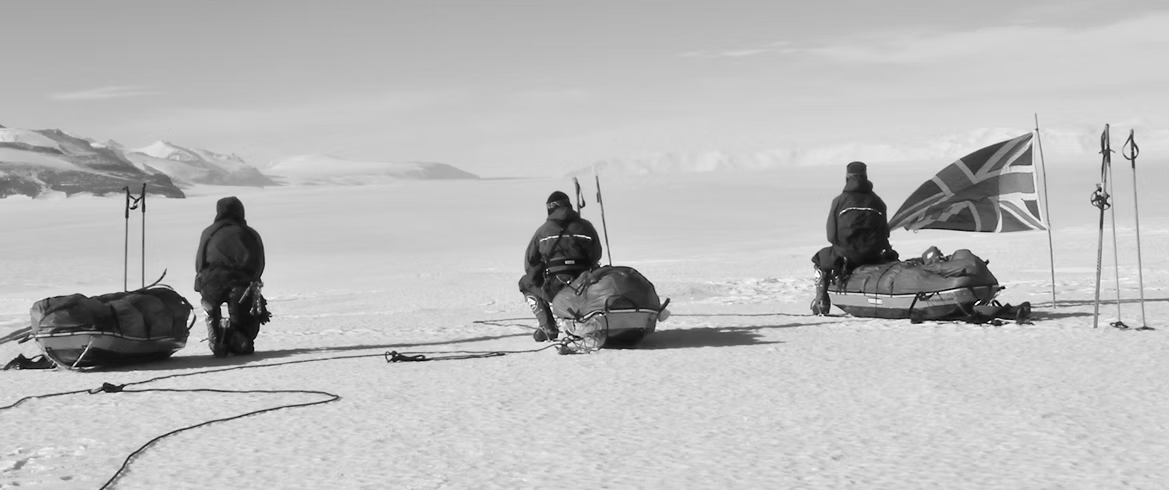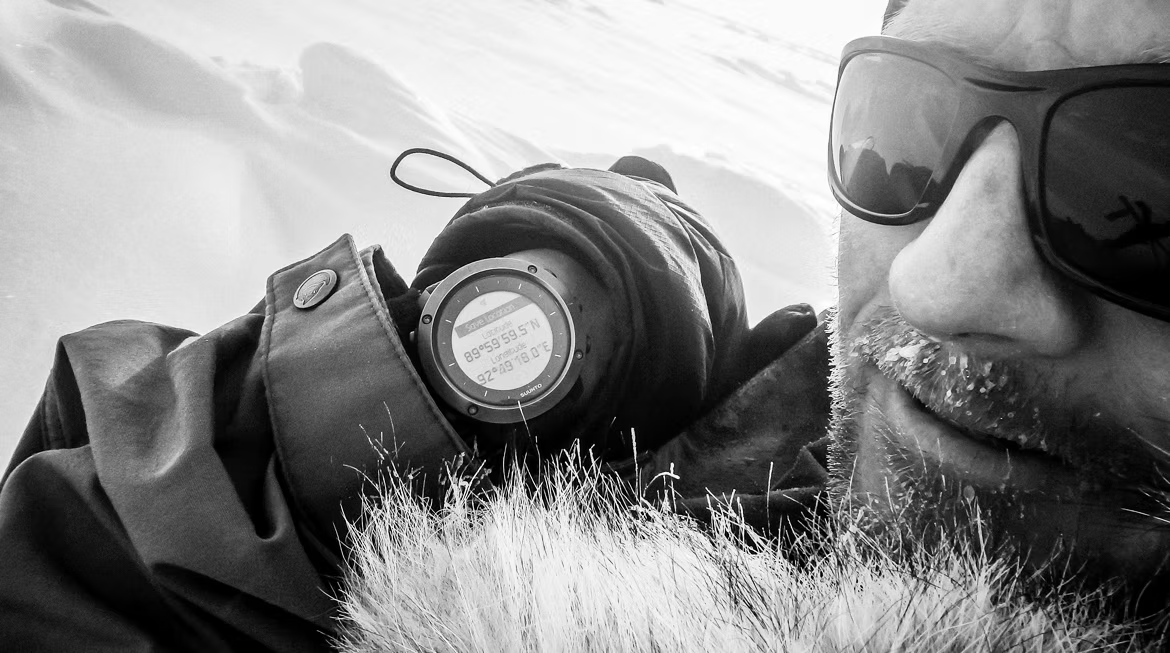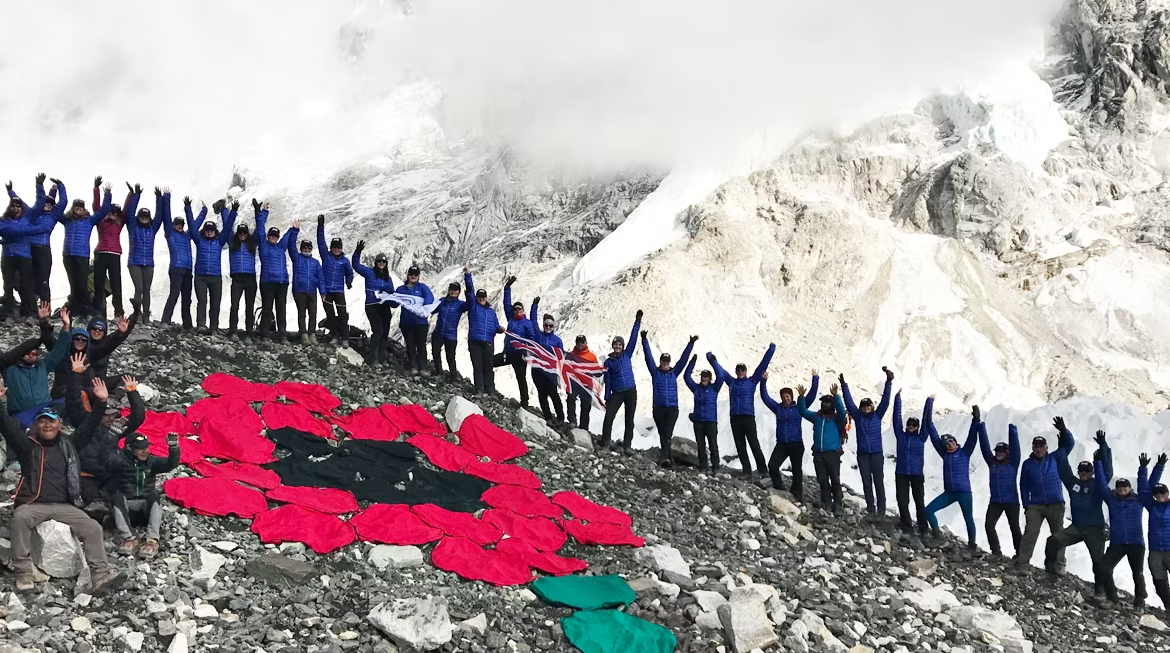
Expeditions
Arctic expeditions such as the one achieved by Vic and his colleagues used the sea ice. These may not be possible in the future and they could be amongst the last expeditions to visit this amazing region.” — Stephan Harris, Climate Scientist, University of Exeter
The Race to the Geographic South Pole
“As a soldier, I might feel invincible in a ‘bubble’, but alone or in a small team of three, walking 76 days on ice, you feel very far from this.”
In 2011, Paul Vicary set off with two teammates to form “Team Scott.” They embarked on a historic journey, re-enacting the original Scott/Amundsen race, making their way on foot in the very footsteps of Captain Scott to the Geographic South Pole (GSP). Setting off from Scott’s hut, exactly 100 years after Captain Scott’s tragic expedition began, Paul and his team faced extreme challenges. They navigated large crevasses, endured temperatures of -40 degrees, battled fierce winds and blizzards, and survived on half rations while stranded on a glacier over Christmas.
Despite the mental and physical hardships, the team’s resilience saw them through. They arrived successfully at the GSP with just 25 minutes to spare, exactly 100 years to the day after Captain Scott’s arrival- truly amazing and not many people know this! This expedition not only marked a monumental achievement but also raised £250,000 for The Royal British Legion to help build ‘Battle Back’ centres for injured servicemen.

Going North: The Geographic North Pole Expedition
“This is 5 years from when I last set off down South in what was one of the hardest things I have ever done in my life – and now I set off again. Why? Good question.”
On returning from an epic and successful South Pole expedition, Paul felt there was more good to be done, and felt the need to create an opportunity to go back on ice, except this time to the North Pole. Arguably one of the most difficult places to reach in the current climate, Paul, and two selected teammates started to plan their intentions in getting to the North Pole unsupported.
The mission was multifaceted. Paul aimed to conduct a ‘Battle Damage Assessment’ (BDA) of the Arctic Ocean, document the devastating effects of climate change, and raise funds for “Hire a Hero,” a charity supporting soldiers transitioning to civilian life. On March 23, 2016, Paul and his team set off with 28 bags of kit. They faced thin ice, melting surfaces, and vast stretches of open water, stark reminders of climate change’s impact. This expedition highlighted the urgent need for climate action and underscored the fragility of this beautiful, harsh environment. The expedition didn’t quite go to plan, faced with these hardships, he and his team had to think on their feet and change the plan as quickly as the environment was changing right before them. A truly remarkable expedition of not quitting and still achieving their mission if if not as planned and a lesson to learn for all of us.

Everest Base Camp: Marking History and Making History
“Trekking to Base Camp was easily the hardest thing I have ever done. Only when sat on that helicopter en route back to Kathmandu, could I appreciate how proud I was, not just of myself but of the whole team for making it there and back safely.”
On September 29, 2017, Paul led a group of 30 military wives and partners to Everest Base Camp (EBC). This eleven-day trek tested the women’s physical and mental endurance, taking them away from their environments, and pushing them beyond their perceived limits. The mission was to raise funds for two charities: Community Action Nepal (CAN) and Family Activity Breaks (FAB).
The expedition raised £60,000 for each charity! The funds supported the construction of earthquake-resistant buildings in Nepal’s Langtang region, an area devastated by the 2015 earthquake. This expedition was particularly significant as it marked the largest group of women to reach Everest Base Camp, commemorating the centenary of Passchendaele, the group laid a giant poppy at the Base Camp, symbolising their collective achievement and honouring historical sacrifices.
These are just some of Paul Vicary’s expeditions which are a testament to human resilience, leadership, and commitment to greater causes. Each journey demonstrates not only pushing the boundaries of current expeditions, but the physical and mental endurance, contributing to vital charitable efforts and raising climate change awareness.

Ready to be inspired by Paul’s incredible journeys?
Click here to learn more and book Paul for your next event.